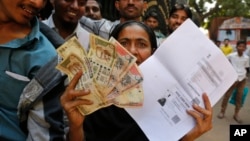India’s Supreme Court has upheld the legality of a sweeping currency ban imposed by Prime Minister Narendra Modi’s government in 2016 that had abruptly removed most cash from the economy.
The government had defended scrapping high value currency notes, saying the measure was meant to root out illegally hoarded cash and to crack down on corruption and terrorist financing. Critics took aim at the shock move that removed 86 percent of cash from circulation. They said it caused massive disruption in India’s huge informal economy and created hardships for tens of millions of poor people.
Modi’s ruling Bharatiya Janata Party hailed the top court’s verdict, but some political analysts said that it should not be seen as a vindication of the controversial measure as it was ruling on the limited issue of the legality of the ban, popularly known as demonetization.
Monday’s judgment came in response to petitioners who had argued that the government did not follow due process before it implemented the radical measure which they said should have been taken in consultation with parliament.
The petitioners said that although the currency ban could not be reversed, the top court should lay down the law for the future, so that "similar misadventures" are not repeated by future governments.
Four of the five judges on the bench said the decision was taken after consultation with the Central Bank for six months and did not “suffer any flaws.”
One dissenting judge, B.V. Nagarathna, however, called the decision “unlawful” and an “exercise of power, contrary to law.” She said parliament should have been consulted on an issue of critical importance to the country.
The court earlier said that its judicial review of demonetization would be restricted to the way in which the decision was taken by the government and not examine issues of economic policy.
Modi had framed his decision as a fight against corruption and said it would target tax evaders with large stockpiles of illicit cash.
Critics pointed to the hardships it created for ordinary Indians. For months, they stood in snaking lines outside banks to exchange their old currency for new notes. Economists said millions of livelihoods in the informal sector were impacted – an estimate by the Center for Monitoring Indian Economy said 3.5 million livelihoods were lost in the year following the currency ban.
Economists also blamed the “arbitrary” move for an economic slowdown and raised questions on whether it achieved its objective of stamping out illicit cash, pointing out that virtually all the money in circulation before the ban was exchanged for the new currency in subsequent months.
Modi’s BJP said Monday’s judgment had upheld the “historic scheme.”
“This whole exercise was done for a valid cause, namely removing fake currency, terror funding, blacking marketing, etc.,” party spokesman Ravi Shankar Prasad told reporters. “The government had the right to take this decision. The court found the decision-making process to be fair and reasonable.”
In a statement, a leader of the opposition Congress Party, Jairam Ramesh, said that the court had not said anything about the impact of demonetization “which was a singularly disastrous decision,” or on whether the measure met its objectives.
Political analysts also pointed out that the court was looking at the limited issue of whether the imposition of the currency ban by the government was legal and not at the broader issue of whether it was a beneficial move.
“The debate on whether it was a good or a disastrous measure cannot be settled by the court. The judges were simply looking at the paperwork that was presented to them on the decision-making process,” points out political analyst Rasheed Kidwai. “But beyond the mere legality of the measure, we must also look at issues of propriety, which should take precedence over just legal issues for governments. We have to see the impact they had on society.”







